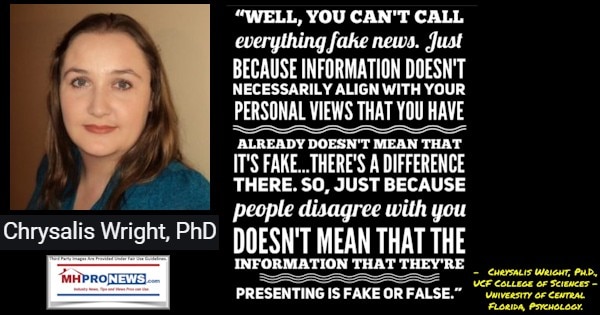
As thousands of daily MHProNews readers know, last week a tipster inside the Manufactured Housing Institute (MHI) orbit provided a surprising admission from MHI’s “Federated States” update. ICYMI, that update is linked below. As was noted, the Federated States are analogous to the state association membership of the Manufactured Housing Executive Committee (MHEC). Once more independent, they have over the years apparently become increasingly aligned with MHI. While on paper, MHI and the Manufactured Housing Association for Regulatory Reform (MHARR) seem to have similar stances in opposition to the looming Department of Energy rule that threatens costly increases on already energy saving manufactured homes. Those mandates could drive up costs that “price out” perhaps over a million potential manufactured home buyers. Rather than allow consumers to select from already energy efficient manufactured homes or give buyers the option to purchase a home with still-higher energy standards than are required, the DOE rule would take away the consumer choice of hundreds of thousands of affordable housing seekers. The differences in approach to how MHI and MHARR have tackled this thorny problem they both agree is a threat is a revealing study in the contrast between words and deeds.
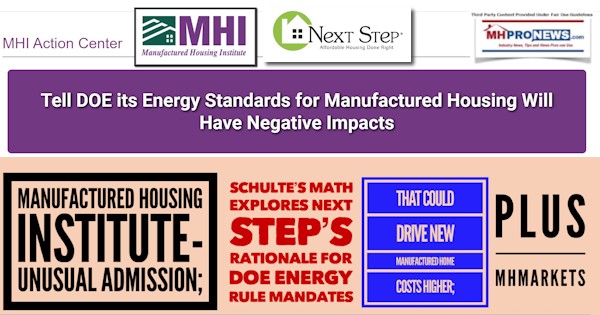
To grasp the distinctions, first see the report linked above. Note that on 3.1.2022 at 7:15 AM ET, the MHI website reports no posts on the topic on the public side of their website.
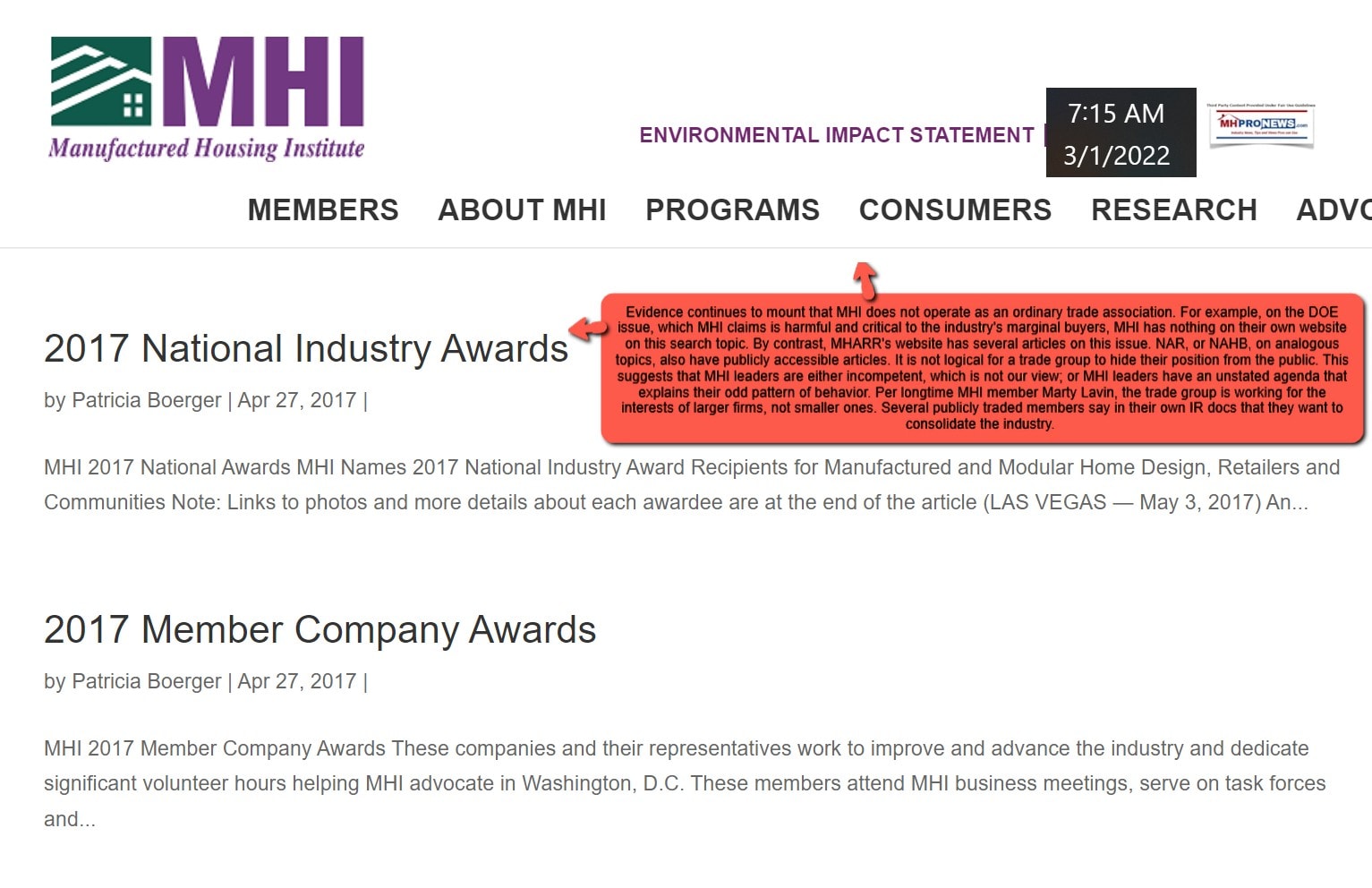
Meanwhile, by contrast, MHARR has published the following for their own website, scheduled it for their email list, and which has been provided to the industry’s trade media, including MHProNews, but not limited to this pro-growth, pro-white hat MHVille brands, pro-consumer trade platform.

Typically, only MHProNews and/or MHLivingNews publishes such MHARR items, although on occasion, MHReview may reprint a MHARR media release. At times, an industry blogger who dances close to the MHI camp, but who weaves back and forth as he thinks wise in his own eyes, will mention a MHARR statement; sometimes citing MHARR favorably, at other times, not.
As noted, there is no MHI provided item on this topic at this time. MHProNews asked MHI leaders for feedback on a range of issues recently, including this one. Apparently, their views are a semi-guarded secret? If so, why? Given that we often obtain their items anyway, what is the logic of their hiding their own content?

By contrast, the latest MHARR statement, dated today, is shown below.

FOR IMMEDIATE RELEASE Contact: MHARR (202) 783-4087
MHARR ASSERTS NEW ARGUMENTS FOR
WITHDRAWAL OF DOE ENERGY RULE
Washington, D.C., March 1, 2022 – In its continuing effort to oppose the unnecessary and costly manufactured housing energy standards rule proposed by the U.S. Department of Energy (DOE), the Manufactured Housing Association for Regulatory Reform (MHARR) has filed comments (attached) opposing the use of a Draft Environmental Impact Statement (Draft EIS) published by DOE on January 14, 2022, in connection with that rulemaking. The Draft EIS, required by the National Environmental Policy Act (NEPA), is one of the few remaining steps in the administrative process for the development of a final DOE energy standards rule, and represents what could be one of the last opportunities for the industry and consumers to submit administrative-level comments opposing the rule.
First, the comments fully set forth MHARR’s position that the entire DOE manufactured housing energy rulemaking, including proceedings related to the Draft EIS are, in fact, stayed and enjoined under a preliminary injunction issued February 11, 2022 by the United States District Court for the Western District of Louisiana in Louisiana v. Biden, Case No. 2:21-CV-01074, barring DOE and other federal defendants from using “Social Cost of Carbon” values in pending and future rulemaking activities. As MHARR initially advised DOE on February 16, 2022, both the Memorandum Ruling issued by the court and subsequent filings by the U.S. Department of Justice (DOJ), make it abundantly clear that not only is DOE generally subject to that injunction, but is also, by DOJ’s admission, specifically enjoined with respect to the DOE manufactured housing energy standards rulemaking. As a result, the DOE manufactured housing energy standards rulemaking, by law, cannot and should not proceed pending final action by either the District Court or a higher-level court.
Second, however, in the event that the court’s current injunction is either stayed or invalidated, and the pending rulemaking proceeds, MHARR’s comments object to the substance of the Draft EIS. Most significantly, MHARR’s findings show that the proposed DOE energy standards are wholly, completely and totally inappropriate for, and inapposite to, today’s modern, affordable post-2000 reform law manufactured homes, which constitute legitimate housing for all purposes, and are instead targeted at the “trailers” of the past, which no longer exist – as is shown by the trendline of manufactured housing energy cost data, which is now below the trendline for site-built homes for all fuel types (i.e., oil, electricity and natural gas).
Furthermore, the Draft EIS, as shown by MHARR’s comments, totally fails to consider the extent and impact of significant individual and societal costs that would flow from the proposed rule including, but not limited to: (1) direct individual and societal-level opportunity and related costs for the millions of Americans who would be excluded from homeownership by the purchase price increases necessitated by the proposed rule; (2) downstream societal costs resulting from the exclusion of millions of Americans from homeownership as a result of purchase price increases necessitated by the proposed rule including, but not limited to: forced utilization of substandard housing; forced utilization of unsafe or unhealthy housing; forced utilization of taxpayer-subsidized housing; physical and/or mental illness resulting from (or exacerbated by) homelessness or housing poverty and related costs; and increases in crime and criminal activity; and (3) failure to consider the diminution of alleged benefits of the proposed rule as a result of the rampant market exclusion of lower-income buyers, among other things. By contrast, if DOE had bothered to fully comply with the express terms of both EISA and the 2000 reform law, it would have gone through the proper procedures to arrive at a legitimate, valid and workable standard for the unique characteristics and affordability of today’s modern manufactured housing, in accordance with section 604 of the Act, rather than nearly two decades of wasted time.
By failing to consider – at all – these and other predictably-significant individual and domestic societal costs of the proposed rule, while simultaneously attempting to pad the rule’s alleged “benefits” with global carbon reduction assumptions, the Draft EIS simultaneously understates the costs of the proposed rule while it simultaneously overstates its alleged benefits contrary to NEPA, the federal Administrative Procedure Act and other applicable law. These fundamental failures, moreover, are in addition to and further exacerbate fatal defects throughout the DOE rulemaking progress, as addressed by MHARR in its previous comments in this matter. As a result, MHARR’s Draft EIS comments call on DOE to withdraw the proposed rule and to instead partner with HUD in a legitimate rulemaking, targeted at the valid energy needs of actual manufactured housing consumers, instead of extremist environmental “activist” groups.
The Manufactured Housing Association for Regulatory Reform is a Washington, D.C.-based national trade association representing the views and interests of independent producers of federally-regulated manufactured housing.
— 30 –
The attached MHARR argument is linked here as a PDF download but is shown below. It provides a level of detail and insights that MHARR’s President and CEO Mark Weiss, J.D., has become known for over the years in his regulatory and other statements.

February 25, 2022
VIA ELECTRONIC SUBMISSION
U.S. Department of Energy
Office of Energy Efficiency and Renewable Energy
Building Technologies Program
1000 Independence Avenue, S.W.
Washington, D.C. 20585
Re: Draft Environmental Impact Statement for Proposed Energy
Conservation Standards for Manufactured Housing (DOE/EIS 0550)
Dear Sir or Madam:
The following comments are submitted on behalf of the Manufactured Housing Association for Regulatory Reform (MHARR). MHARR is a Washington, D.C.-based national trade organization representing the views and interest of producers of manufactured housing regulated by the U.S. Department of Housing and Urban Development (HUD) pursuant to the National Manufactured Housing Construction and Safety Standards Act of 1974 (1974 Act), as amended by the Manufactured Housing Improvement Act of 2000 (42 U.S.C. 5401, et seq.) (2000 reform law), and subject to energy-related regulation by the U.S. Department of Energy (DOE) pursuant to section 413 of the Energy Independence and Security Act of 2007 (EISA).[1] MHARR was founded in 1985. Its members include independent producers of manufactured housing from all regions of the United States.
I. INTRODUCTION
On January 14, 2022,[2] the U.S. Department of Energy published a Draft Environmental Impact Statement (EIS) in connection with its August 26, 2021 Supplemental Notice of Proposed Rulemaking (SNPR) concerning manufactured housing “energy conservation” standards.[3] In a notice published contemporaneously with the Draft EIS, DOE invited interested parties “to comment on how [the] analysis presented in the Draft EIS should inform the final energy conservation standards for manufactured housing.”[4]As the comments below indicate, the Draft EIS, in the view of MHARR, as a national representative of small and medium-sized manufactured housing producers, further confirms that the proposed DOE manufactured housing energy conservation standards – both as initially set forth and as modified through a Notice of Data Availability (NODA) published on October 26, 2021[5] – are a baseless exercise in regulatory overkill that will further undermine the nation’s supply of affordable housing and homeownership,[6] needlessly exclude millions of lower and moderate-income Americans from the manifold benefits of homeownership, and simultaneously batter a manufactured housing industry that has already seen more than a decade with production levels far below historic norms.[7] Indeed, as the Draft EIS illustrates, the DOE proposed standards will affirmatively harm the mainstream HUD Code manufactured housing market and those Americans seeking inherently affordable non-subsidized homeownership, while providing alleged environmental “benefits” that are de minimis or non-existent, particularly in relation to the economic damage and market disruption that they would cause.
More immediately, further activity in this proceeding, including but not limited to the underlying substantive manufactured housing energy standards rulemaking and consideration of the Draft EIS, is subject to and is preliminarily enjoined pursuant to an order entered by the United States District Court for the Western District of Louisiana on February 11, 2022 in litigation styled Louisiana v, Biden, Case No. 2:21-CV-01074. The court opinion granting that injunction, as explained in greater detail below, specifically cites and references the present rulemaking as an example of regulatory activity subject to the court’s nationwide injunction. Both DOE and its Secretary, moreover, are named defendants in that proceeding.
In accordance with that ruling and without waiving any of its procedural or substantive rights with respect thereto, MHARR again calls on DOE to withdraw its August 26, 2021 proposed standard in its entirety and, instead, engage in a legitimate rulemaking proceeding in conjunction with HUD and in accordance with all applicable federal law, to develop cost-effective energy standards that are appropriate for the unique attributes of HUD Code manufactured housing and the HUD Code manufactured housing market.
II. BACKGROUND AND PROCEDURAL HISTORY
The procedural history of this rulemaking, through and including the publication of the instant notice on January 14, 2022, is set forth in detail in written comments filed by MHARR on August 8, 2016 and October 25, 2021.[8] That history demonstrates that: (1) the standards proposed by DOE pursuant to its August 26, 2021 SNPR; (2) amended by DOE pursuant to its October 26, 2021 NODA; and (3) purportedly addressed by its January 14, 2022 Draft EIS, are the product of – and are irretrievably tainted by – a fundamentally illegitimate DOE administrative process, including a sham “negotiated” rulemaking, resulting in fatal defects that have not and cannot be remedied through the present “supplemental” proceeding. To the contrary, the elemental bankruptcy of the amended proposed standards and this entire proceeding is actually confirmed by the Draft EIS.
Subsequent to the January 14, 2022 publication of the Draft EIS, however, proceedings in this docket, as specifically acknowledged and confirmed by DOE and the U.S. Department of Justice in relevant court filings, have been stayed pursuant to a preliminary injunction issued by the U.S. District Court for the Western District of Louisiana in Louisiana v. Biden, supra. The ruling in that case preliminarily enjoins U.S. government agencies – specifically including DOE, a named defendant in that litigation, together with its secretary – from using “Social Cost of Carbon” (SCC) values published by an “Interagency Working Group” (IWG) in February 2021 in connection with federal rulemaking activity. Specifically, the February 11, 2022 Order prohibits DOE from:
- Adopting, employing, treating as binding, or relying upon the work product of the Interagency Working Group (IWG);
- Independently relying upon the IWG’s methodology considering global effects, discount rates and time horizons;
- Adopting, employing, treating as binding, or relying on any Social Cost of Greenhouse Gas estimates based on global effects or that otherwise fail to comply with applicable law;
- Adopting, employing, treating as binding, or relying upon any estimate of Social Cost of Greenhouse Gasses that does not utilize discount rates of 3 and 7 percent or that does not otherwise comply with [Office of Management and Budget] Circular A-4;
- Relying upon or implementing Section 5 of Executive Order 13990 in any manner.
In addition, the court’s order affirmatively directs DOE and the other named federal defendants to “return to the guidance of Circular A-4 in conducting regulatory analysis.”
It is beyond dispute that the February 11, 2022 preliminary injunction issued by the court in Louisiana v. Biden, supra applies to this proceeding, insofar as:
- Both DOE and its Secretary, Jennifer Granholm, as stated above, are named defendants in that action;
- The DOE manufactured housing energy standards rulemaking is specifically cited by the court in its February 11, 2022 Memorandum Ruling as an example of a proposed rule which utilizes the February 2021 SCC values “to increase costs;”[9]and
- The U.S. Department of Justice (DOJ), in a February 19, 2022 filing with the issuing court, expressly acknowledges that the DOE manufactured housing energy standards rulemaking, including the Draft EIS and related proceedings pursuant to the National Environmental Policy Act are subject to the February 11, 2022 injunction.[10]
Further, as DOJ – and, by extension, DOE — expressly acknowledge in the February 19, 2022 Declaration filed together with their request for a stay of the February 11, 2022 preliminary injunction, the SCC values are integral to the cost-benefit analyses required for manufactured housing energy standards by EISA section 413 and by the federal Administrative Procedure Act. Consequently, MHARR, in a February 16, 2022 communication to DOE Secretary Jennifer Granholm, called on DOE to immediately suspend all proceedings, in accordance with the court’s February 11, 2022 order, in both the core manufactured housing energy standards rulemaking and in proceedings related to the Draft EIS and compliance with the National Environmental Policy Act (NEPA). That communication states, in relevant part: “Insofar as both the August 26, 2021” Supplemental Notice of Proposed Rulemaking and “the October 26, 2021” Notice of Data Availability in this matter “expressly and elementally rely upon greenhouse gas emission reduction values as updated by the IWG in February 2021,” the District Court’s “order specifically enjoins DOE from taking any further action in this matter based on the current proposed rule and the current rulemaking record.”[11]MHARR hereby reiterates that demand to cease and desist, and reserves its right to seek other and further relief in the event that DOE fails to comply with the District Court’s February 11, 2022 order.
In the event, however, that the February 11, 2022 preliminary injunction is overturned on appeal or otherwise dissolved prior to the entry of a permanent injunction applicable to this matter, MHARR provides herein its substantive comments and objections to the Draft EIS. Based on those objections and its previously-stated opposition to DOE’s manufactured housing energy standards proposed rule, the proposed standards should be withdrawn, this entire proceeding should be terminated without the publication of a final rule, and DOE should instead initiate a completely new, legitimate rulemaking in conjunction with HUD to establish any additional or updated manufactured housing energy standards that may justifiably be needed, if any, based on a complete, proper and valid cost-benefit analysis.
III. COMMENTS
A. THE DOE RULE IS INAPPROPRIATE AND UNNECESSARY FOR
MODERN POST-2000 REFORM LAW MANUFACTURED HOMES
Most fundamentally, as is reiterated in greater detail below, the DOE proposed rule for manufactured housing energy standards is not appropriate – and, more importantly, not needed – for today’s modern, affordable manufactured homes. While the manufactured housing industry is historically rooted in – and evolved from – the “trailers” of the post-World War Two era, today’s modern, affordable manufactured homes, as constituted and constructed following Congress’ adoption of the Manufactured Housing Improvement Act of 2000 are, in every sense, legitimate housing, on par with and comparable to any other form or type of housing, including site-built homes. DOE’s proposed manufactured housing energy standards rule, however, in development since the adoption of EISA in 2007, either completely ignores or rejects the evolution of manufactured homes beyond the “trailers” of yesteryear, to the status of legitimate housing for all purposes. As a result, the proposed rule is completely unsuited to – and unnecessary for – the modern, affordable manufactured homes being produced today, fully 15 years following EISA’s enactment.
The evolution of today’s modern, affordable manufactured housing, which DOE refuses to acknowledge or recognize in the present rulemaking, is reflected by the trend in energy utilization costs paid by manufactured housing residents, as tracked by the U.S. Census Bureau. As MHARR emphasized in its August 8, 2016 comments in response to a prior DOE proposed manufactured housing energy rule, the 2013 American Housing Survey (AHS) showed that manufactured housing residents, on a whole home basis, paid less per month for oil and natural gas than site-built housing residents, and only slightly more for electricity.[12]Post-2000 reform law manufactured homes, accordingly, by 2013, provided greater energy affordability than single-family, site-built homes, on a whole-home basis, in two of the three energy source categories tracked by the Census Bureau. That performance, however, as could reasonably be expected under the 2000 reform law, has improved even further, according to the most recent AHS data. That data, contained in the 2019 AHS, shows that the energy affordability of manufactured homes, on a whole-home basis, now exceeds that of detached, single-family site-built homes in all three home energy categories, including electricity.[13]None of this ongoing and significant progress, however, is reflected in, or considered in relation to the DOE proposed rule and the Draft EIS. Instead, DOE, the proposed rule and the Draft EIS improperly and unlawfully treat manufactured homes – and their energy performance – as somehow being mired in the last century, thus ignoring proof of clear and significant energy progress while seeking to justify or rationalize draconian mandates that are not only unnecessary, but that would be destructive of manufactured housing as a key source of affordable, non-subsidized homeownership for millions of lower and moderate-income Americans.
On this ground alone, the proposed rule and Draft EIS are improper and unacceptable as a matter of law. Modern, affordable manufactured homes, comprising 100 percent of new HUD Code home sales and a steadily-growing proportion of the nation’s total manufactured housing stock, already provide energy affordability.
B. THE DRAFT EIS DOES NOT CALCULATE THE FULL COSTS
AND NEGATIVE IMPACTS OF THE PROPOSED STANDARDS
In its August 3, 2021 comments on DOE’s original Notice of Intent to Prepare an Environmental Impact Statement for Energy Conservation Standards for Manufactured Housing,[14] MHARR stated, in part, that DOE manufactured housing energy conservation standards would “inevitably have a significant negative impact on the purchase price and availability of HUD-regulated manufactured housing, as well as substantial negative downstream impacts on Americans in need of affordable housing, lower and moderate-income homebuyers and minority homebuyers,” affecting “homelessness, racial equity and economic justice,” among other matters. (Emphasis in original). MHARR, accordingly, asserted that “each of these immediate and downstream impacts, under relevant federal law and directly applicable Administration policy must be addressed and resolved” through the energy standards EIS “prior to the adoption of any final standards in this matter.” (Emphasis in original). The Draft EIS, however, totally fails to quantify or address the full range of individual and societal costs, and negative impacts that would result from the proposed (and amended) manufactured housing energy standards rule published by DOE. As a result, the Draft EIS is fatally and intrinsically defective and fails to meet the substantive requirements of applicable law including, but not limited to, EISA section 413[15] and applicable sections of the National Manufactured Housing Construction and Safety Standards Act of 1974 as amended by the Manufactured Housing Improvement Act of 2000.[16]
- THE EIS DOES NOT ESTIMATE OR CONSIDER
THE FULL COST OF THE PROPOSED STANDARDS
As an initial matter DOE, after a 15-year rulemaking process, has not – either in the Draft EIS or otherwise – estimated, calculated, or even attempted to estimate or calculate the full, direct, individual-level and national-level costs of its proposed standards including, but not limited to: (1) the number of lower and moderate-income Americans who would be excluded from the manufactured housing market and from homeownership altogether as a result of purchase price cost increases driven by the proposed standards; (2) the full implementation cost of the proposed rule including, but not limited to, testing, regulatory compliance and enforcement costs[17] that DOE acknowledges it has never calculated or estimated; and (3) the full panoply of individual and societal costs that would proximately result from the level and degree of homeownership exclusion that would result from the proposed standards and corresponding purchase price increases, including, but not limited to, loss of homeownership equity, loss of Gross Domestic Product (GDP), loss of housing opportunity, loss of state and local property tax revenues, and increased demand for federal, state and local housing subsidies and related subsidized services arising from a decline in homeownership, among other things.
Given this failure, the partial and incomplete “analysis” presented in the Draft EIS is fatally skewed and inaccurate insofar as it fails to reflect the full costs of the proposed rule for each affected consumer. And, to the extent that the Draft EIS fails to fully reflect individual costs, it necessarily fails to reflect cumulative societal costs. Indeed, such a calculation or estimate, within any reasonable degree of confidence, is for all intents and purposes, impossible on the current state of the record, meaning that the cost-effectiveness mandate of EISA section 413 and parallel mandates of federal manufactured housing law, are not and cannot be met by the Draft EIS. Accordingly, due to the lack of this key information – a critical, necessary and essential component of any legitimate cost-benefit inquiry and analysis – an accurate and valid EIS is not possible and has not been developed or presented in this proceeding. Consequently, the Draft EIS is incomplete and invalid as it fails to project, analyze and/or consider the full direct costs of the proposed rule. And lacking, ab initio, the full costs of the proposed rule, neither this Draft EIS or any EIS could reach a valid, legitimate and accurate conclusion regarding the cost-benefit impact of the proposed rule within any legitimate metric of measurement or analysis. As a result, the Draft EIS is invalid and insufficient, ab initio, as a matter of law.
- THE EIS DOES NOT ESTIMATE OR CONSIDER THE EXTENT AND
FULL COSTS OF REGULATORY-DRIVEN MARKET EXCLUSION
Further, and even more significantly, the Draft EIS does not calculate or seek to estimate or model the degree of market exclusion and related individual and societal costs that would result from manufactured home purchase price increases directly attributable to the proposed energy standards. Nor, as noted above, is such an estimate or model even possible on the present state of the record. As a result, the proposed rule, cannot be subject to a legitimate cost-benefit analysis, and cannot proceed to a final rule as a matter of law.[18]
Specifically, and as MHARR detailed in its October 25, 2021 and November 22, 2021 comments in this matter, manufactured home purchase price increases of the magnitude that would be required by the proposed standards – and particularly the proposed “Tier 2” standards, which most DOE-supportive commenters seek to be applied across-the-board to all manufactured homes regardless of price or size[19] – would result in the exclusion millions of mostly lower-income purchasers from the manufactured housing market entirely. MHARR has estimated that retail-level price increases flowing from the DOE-proposed standards (not including regulatory compliance, testing and enforcement-related costs) would be $6,279.00 for a single-section manufactured home and $9,366.00 for a double-section home. Based on manufactured housing-specific metrics developed by the National Association of Home Builders (NAHB)[20] and submitted as part of the record of the 2014-2015 DOE “negotiated rulemaking” in this matter – the only such evidence of price impact to be offered – price increases of this magnitude would exclude more than 2,156,986 households from the HUD Code single-section market, and more than 2,933,080 households from the HUD Code double-section market, for a total of over 5,090,006 households, representing 54 years of industry production at 2020 market levels.
This level and degree of market exclusion, in turn, has significant associated costs that are not accounted for in the Draft EIS and have likely never been accounted for or even estimated. Insofar as manufactured housing, at present, provides an affordable, non-subsidized source of housing and homeownership for those who would not have sufficient income or resources to purchase or access other types of housing, significant increases in the purchase price of manufactured housing would lead to the market exclusion of those who currently are only marginally able to afford a manufactured home and obtain necessary financing. The large-scale exclusion of those current purchasers from the mainstream HUD Code market, given their marginal economic status, would inevitably lead to a higher degree of homelessness in the United States. As recently as 2015, HUD estimated the cost of homelessness to taxpayers to be approximately $40,000 per homeless person, per year.[21] With market exclusion levels attributable to the proposed rule affecting millions of families according to the NAHB market exclusion metric, the added costs of homelessness, alone, resulting from the proposed rule, would number in the hundreds of billions.[22]None of these foreseeable societal costs, however, are captured or even estimated by the Draft EIS. Nor are numerous other downstream societal costs attributable to a sudden and substantial loss of affordable housing opportunity, captured or considered by the Draft EIS. These include, but are not limited to, increases in: (1) forced utilization of substandard housing; (2) forced utilization of unsafe or unhealthy housing; (3) forced utilization of taxpayer subsidized housing; (4) physical and/or mental illness resulting from (or exacerbated by) homelessness or housing poverty and related costs;[23] and (5) increases in crime and criminal activity,[24] among many others.
Nor does the Draft EIS address the racial equity impacts that would result from the proposed rule, contrary to the specific directive of President Biden’s January 26, 2021 “Memorandum on Redressing Our Nation’s and the Federal Government’s History of Discriminatory Housing Practices and Policies.” Among other things, May 2021 data published by the Consumer Financial Protection Bureau (CFPB) shows that “only a minority (27 percent) of consumers who applied for a loan to purchase a manufactured home succeeded in obtaining financing” and that 50 percent of chattel (i.e., personal property) purchase loan applications “were denied.” More significantly, the 50 percent rejection level for manufactured home personal property loans — representing nearly 80 percent of the entire manufactured housing new home market, according to U.S. Census Bureau statistics – disproportionately affected and harmed minority communities. As noted by CFPB: “Black and African American borrowers are the only racial group that are … overrepresented in chattel lending compared to site-built.”[25]With “Black and African American borrowers” already subject to disproportionately-high purchase loan rejection rates within the mainstream HUD Code manufactured housing market, extreme purchase price increases resulting from the proposed rule will predictably and, indeed, inevitably result in: (1) even higher loan rejection rates for personal property loans; (2) even greater disproportion in loan rejection rates for minority communities and specifically Black and African Americans; and (3) a corresponding decrease in homeownership for minority communities and particularly Black and African Americans, contrary to the policies of President Biden. Yet, the Draft EIS addresses none of this data.
Notwithstanding these and other readily foreseeable societal costs resulting from the extreme degree of market exclusion – particularly at the lowest income levels and among the most marginalized populations — that would result from the DOE proposed standards (and would be exacerbated by additional non-accounted-for regulatory compliance costs), the EIS makes no attempt to either quantify or consider that exclusionary impact or its downstream consequences[26] on either an individual or societal basis.[27]Again, therefore, the Draft EIS is necessarily incomplete, inadequate and insufficient as a matter of law.
- BY DEFINITION THERE ARE NO “LIFE-CYCLE
BENEFITS” FOR THOSE EXCLUDED FROM THE MARKET
While the Draft EIS makes much of the alleged life-cycle savings (LCC) that DOE maintains would be attributable to its proposed standards,[28] the Draft EIS fails to recognize or account for the fact that for potential purchasers wholly excluded from the mainstream HUD Code manufactured housing market by the extreme purchase price increases attributable to the proposed rule, there would be no “savings” – either “life-cycle” savings or otherwise (because they would not be able to purchase the home in the first place), and, therefore, no benefits, per se. To the contrary, as MHARR has emphasized previously, for those excluded consumers, there would only be “costs” – i.e., the opportunity cost of total exclusion from the market, exclusion from all of the benefits of affordable, non-subsidized homeownership and, conversely, exposure to all or some of the downstream costs of housing exclusion – none of which is considered or accounted-for by the Draft EIS. For example, the Draft EIS states, in part: “The LCC savings (10-year and 30-year periods) and the increased purchase price, increased annual energy savings, and simple payback period are estimated to be the same for Tier 1 under Alternative A2 as they are under Alternative A1.”[29] Thus, while the LCC calculation apparently amortizes alleged acquisition cost increases for home purchasers who can afford those increases and still qualify for purchase-money financing, the Draft LCC does not account, in these calculations, for the cost impact of total exclusion from the market. Put differently, there is an individual and societal-level impact from excluding potential lower-income purchasers from the market that is not captured and is clearly not intended to be captured by the Draft EIS’ analysis and calculations. As a result, the Draft EIS is materially skewed toward showing alleged benefits attributable to the proposed standards, while failing to fully quantify and consider the proposed standards’ full costs.
The skewing of these calculations and analyses in favor of alleged benefits flowing from the proposed standards is exacerbated, moreover, by the inclusion of 2021 SCC data showing alleged national and global climate mitigation “benefits” from the proposed rule. For all of the reasons cited by the plaintiff states in Louisiana v. Biden, supra, however, those metrics are, at a minimum, fundamentally arbitrary and capricious. As a result they should not, and pursuant to the preliminary injunction entered by the court in that case, cannot, be used to offset, in any manner, the full and complete costs of the proposed rule in this matter, or be used in any manner to justify or rationalize that proposed rule. The Draft EIS, then, as it stands today, materially and unlawfully understates the full costs of the proposed standards by failing to consider and account-for mass market exclusion and resulting downstream societal impacts, while it simultaneously and unlawfully overstates the alleged benefits of the rule by padding those supposed benefits with alleged SCC “savings.” Again, therefore, the Draft EIS is fundamentally arbitrary, capricious and unlawful, and should be withdrawn.[30]
C. ALLEGED CLIMATE BENEFITS OF THE PROPOSED RULE WOULD
WOULD BE MINISCULE IN RELATION TO ITS ECONOMIC COSTS
Further, even under the skewed, fundamentally baseless “analysis” presented in the Draft EIS, the supposed environmental “benefits” of the proposed rule would be absolutely minimal and arguably inconsequential, compared to the individual and societal costs that the proposed standards would impose. The Draft EIS thus states: “The proposed action and action alternatives would reduce GHG emissions by … 2.7 – 3.4 million MT CO2 per year, which equates to about 0.3-0.4 percent of the residential sector emissions in 2020.” (Emphasis added). The Draft EIS goes on to assert that “manufactured housing is a small fraction of all U.S. housing (about 6 percent, but on a household basis, consumes more electricity, on average, than other types of homes. Therefore, the relative contribution to GHG emissions would be somewhat higher and the reduction in GHG emissions would be more beneficial than what might be inferred from a simple scaling of manufactured housing to all U.S. homes.”[31]Again, though, these claims are baseless and essentially fraudulent.
First, even if the Draft EIS’ analysis were accurate (which it demonstrably is not, as is explained above), the proposed DOE standards, while resulting in: (1) thousands of dollars in additional purchase costs for consumers; (2) the elimination of literally millions of potential homebuyers from the market; (3) further undermining racial equity within the manufactured housing consumer financing market; and (4) necessitating hundreds of billions of dollars in additional governmental and societal costs to address the direct and indirect costs of homelessness exacerbated by regulatory-driven manufactured housing market exclusion, would achieve GHG emission reductions of less than one-half of one percent of the entire residential housing sector in 2020.[32]In exchange for massive market disruption, therefore, as well as corresponding human misery and the crippling of the nation’s premier source of inherently-affordable, non-subsidized homeownership, greenhouse gas emissions under the DOE proposed “standards” would be 99.6 to 99.7% unchanged. Perhaps DOE, in the next iteration of the EIS, could calculate for any reviewing court, how many billions of dollars in additional costs and human suffering each one-tenth of one percent of GHG emissions reductions would cost.
Second, DOE’s contention – in its useless effort to support non-sensical, non-economical and non-beneficial manufactured housing energy standards – that manufactured homes “on a household basis,” consume “more electricity than other types of homes,”[33]is patently false. While that assertion may have been correct at the time that the U.S. Census Bureau’s 2013 American Housing Survey was published and cited by MHARR in its August 8, 2016 comments on DOE’s first proposed manufactured housing energy standards rule,[34]it is not correct today. To the contrary, the newer data published in the 2019 AHS, shows that manufactured homes have lower median monthly energy costs than detached, site-built homes in all major fuel categories, including electricity. Thus, according to the 2019 AHS, the monthly average electricity cost for a HUD Code manufactured home is $122.00 per month, as compared to $124.00 per month for detached site-built homes. Consequently, unless electricity in the United States is being consumed free of charge, the whole-home electricity consumption of a manufactured home, according to the 2019 AHS data, is less than the whole-home electricity consumption of site-built homes, contrary to the Draft EIS’ baseless contention.
Consequently, while the DOE proposed standards would have devastating negative impacts for manufactured housing consumers, the manufactured housing industry and the United States as a whole, it would achieve virtually no energy savings, greenhouse gas emission reductions, or climate benefits as effectively acknowledged by DOE. So, not only does the proposed rule harm lower and moderate-income Americans, it will do so while producing essentially no climate benefits, even under the solicitous parameter established by DOE. Put simply, the proposed rule offers only costs, with no corresponding benefits.
IV. CONCLUSION
For all of the foregoing reasons, as well as those set forth in MHARR’s previous comments in this docket, DOE’s proposed manufactured housing energy conservation standards rule, as modified, should be withdrawn and the present rulemaking docket terminated. Those proposed standards, as presented by DOE’s August 26, 2021 SNPR, as modified by DOE’s October 26, 2021 NODA, and as addressed by the Draft EIS herein, are extreme, unnecessary, and fundamentally inappropriate for today’s modern manufactured housing and the lower and moderate-income American families that predominately rely on those homes. Instead, DOE should initiate a new, untainted rulemaking proceeding, in conjunction with HUD and in accordance with all applicable federal law, to develop manufactured housing standards (if any) that are: (1) legitimately necessary; (2) appropriate for inherently affordable manufactured housing; and (3) cost-effective and cost-beneficial for all manufactured housing purchasers.
Sincerely,
Mark Weiss
President and CEO
cc: Hon. Marcia Fudge
Hon. Shalanda Young
HUD Code Manufactured Housing Industry Members and Consumers
MHARR Footnotes
[1] See, 42 U.S.C. 17071.
[2] See, 87 Federal Register, No. 10 (January 14, 2022) “Energy Conservation Standards for Manufactured Housing,” pp. 2359, et seq.
[3] See, 86 Federal Register, No. 163 (August 26, 2021) “Energy Conservation Standards for Manufactured Housing.” pp. 47744, et seq.
[4] See, 87 Federal Register, supra at p. 2359, col. 1.
[5] See, 86 Federal Register, No. 204 (October 26, 2021) “Energy Conservation Standards for Manufactured Housing: Availability of Provisional Analysis,” pp. 59042, et seq. While the October 26, 2021 NODA did not specifically assert that it constituted an amendment of the proposed standards published by DOE on August 26, 2021, DOE’s January 14, 2022 notice and Draft EIS both treat $63,000 as the retail price demarcation line between proposed “Tier 1” and “Tier 2” standards, rather than the $55,000 amount originally proposed in the August 26, 2021 SNPR.
[6] See, e.g., Wall Street Journal (April 16, 2021) “U.S. Housing Market is Nearly 4M Homes Short of Buyer Demand:” “The U.S. housing market is 3.8 million single-family homes short of what is needed to meet the country’s demand, according to a new analysis by mortgage-finance company Freddie Mac. The estimate represents a 52% rise in the nation’s home shortage compared with 2018, the first time Freddie Mac quantified the shortfall. The figures underscore the severity of the housing deficit…. The shortage is especially acute for entry-level homes, which makes it more expensive for first-time home buyers to enter the market….” (Emphasis added).
[7] Even though HUD Code manufacturers produced 105,772 homes in 2021, this remains far below the industry’s 30-year and 20-year production averages.
[8] See also, MHARR comments submitted on February 22, 2010 (Advance Notice of Proposed Rulemaking); July 24, 2013 (2013 Request for Information); March 13, 2015 (2015 Request for Information); September 17, 2018 (2018 Request for Information); August 3, 2021 (Notice of Intent to Prepare Environmental Impact Statement); November 22, 2021 (October 26, 2021 Notice of Data Availability).
[9] See, Louisiana v. Biden, supra, Memorandum Ruling (February 11, 2022) at p. 17.
[10] See, Louisiana v. Biden, supra, Defendants’ Motion for a Stay Pending Appeal (February 19, 2022), Exhibit 1, Declaration of Dominic J. Mancini, Deputy Administrator of the Office of Information and Regulatory Affairs (OIRA) at pp. 12-13:The Department of Energy (DOE) is under a court-ordered deadline to issue final energy conservation standards for manufactured housing by May 16, 2022. To finalize those standards, DOE must complete its review under NEPA, and the 45-day comment period on the draft environmental impact statement (‘EIS’) will end in approximately two weeks. In the draft EIS on the alternative standards being considered for manufactured housing, DOE directs the public to review its recent presentations of the various alternatives’ climate effects using [SCC] estimates to ‘help the public … understand or contextualize the potential impacts of [greenhouse gas] emissions’ and to ‘inform a comparison of alternatives.’ I understand that public commenters specifically requested DOE to present estimates of {SCC costs] in the [draft EIS] to contextualize the alternatives. Contextualizing alternatives for the public is a key requirement under NEPA. If DOE cannot employ the Interim [SCC] Estimates to help contextualize the climate effects of alternative standards in the final EIS, and needs to develop new, additional analysis to help properly contextualize those effects, I understand it could complicate concluding the environmental review in time to meet the court deadline. Similarly, because the manufactured housing standards will have significant economic costs, cost savings and other effects, DOE is required by EO 12866 to quantify the costs and benefits of alternatives in a [regulatory impact analysis] to accompany publication of the final standards. If DOE cannot continue to use the Interim [SCC] Estimates for purposes of its EO 12866 analysis, and in the development of a record to support their rulemaking under DOE’s statutory criteria for setting energy efficiency standards, the development of a new adequate presentation of all the relevant costs and benefits could complicate DOE’s ability to satisfy its requirements under EO 12866 and the statute in time to meet the court-ordered deadline.” (Internal citations omitted).
[11] See, MHARR February 16, 2022 communication to DOE Secretary Jennifer Granholm, attached hereto as Exhibit 1.
[12] I.e., a difference of $168.00 per year.
[13] See, e.g., MHARR’s October 25, 2021 comments on the current DOE proposed rule, at p. 6.
[14] See, 86 Federal Register, No. 127 (July 7, 2021) “Notice of Intent to Prepare an Environmental Impact Statement for Energy Conservation Standards for Manufactured Housing,” at pp. 35773-35775.
[15] As MHARR has consistently emphasized in its previous comments in this docket, EISA section 413 expressly requires DOE to consider the purchase price impact of any proposed manufactured housing energy conservation standards, stating, in relevant part: “The energy conservation standards established under this section shall be based on the most recent version of the International Energy Conservation Code (including supplements) except in cases in which the Secretary finds that the code is not cost-effective … based on the impact of the code on the purchase price of manufactured housing and on total life-cycle construction and operating costs.” (Emphasis added).
[16] Multiple sections of the 1974 Act, as amended by the 2000 reform law, address the primacy of manufactured housing purchase price affordability. See, e.g., 42 U.S.C. 5401(a)(2) (“Congress finds that manufactured homes provide a significant resource for affordable homeownership … accessible to all Americans”); 42 U.S.C. 5401(b) “The purposes of this title are” (1) “to protect the quality, durability safety and affordability of manufactured homes”, (2) “to facilitate the availability of affordable manufactured homes and increase homeownership for all Americans,” and (8) “to ensure that the public interest in, and need for, affordable manufactured housing is duly considered in all determinations relating to the federal standards and their enforcement;” and 42 U.S.C. 5403(e)(4) “The Secretary, in establishing standards or regulations … shall… consider the probable effect of such standard on the cost of the manufactured home to the public.”
[17] See, 86 Federal Register, supra at p. 47759, col. 1: “DOE is not proposing any testing, compliance or enforcement provisions at this time. DOE has also not included any potential associated costs of testing, compliance or enforcement.” (Emphasis added). Notwithstanding this declaration, it is obvious and known by DOE that regulatory compliance costs related to the proposed standards will not be zero and, in all likelihood, would be substantial, particularly for smaller businesses which are disproportionally impacted by federal regulation and regulation-related costs. See, U.S. Small Business Administration, “The Impact of Regulatory Costs on Small Firms” (September 2010).
[18] See, Executive Order 12866 (“Regulatory Planning and Review”), September 30, 1993, Section I (b)(6): “Each agency shall assess both the costs and the benefits of the intended regulation and, recognizing that some costs and benefits are difficult to quantify, propose or adopt a regulation only upon a reasoned determination that the benefits of the intended regulation justify its costs.”
[19] See, e.g., November 24, 2021 comments submitted in the present docket by Next Step, Inc. at p. 10: “Next Step supports a single-tier standard for energy conservation based on the 2021 IECC standard as required by the Energy Independence and Security Act of 2007. Homebuyers purchasing single-section homes should not be subjected to the pitfalls of lower-quality, inefficient homes.”
[20] NAHB statistical analysis indicated that for each $1,000 increase in the retail level purchase price of a manufactured home, 347,901 households would be excluded from the single-section HUD Code manufactured housing market and 315,385 households would be excluded from the double-section HUD Code manufactured housing market.
[21] See, Politifact (June 11, 2015): “HUD Secretary Says a Homeless Person Costs Taxpayers $40,000 a Year.”
[22] The exclusion of more than 5,000,000 families from the HUD Code manufactured housing market as a result of increased purchase prices driven by the proposed DOE standard, in accordance with the NAHB-developed exclusion metric, would result in more than $200 billion in additional societal costs.
[23] See, University of Pennsylvania, “The Cost of Homelessness: A Perspective from the United States,” Dennis P. Culhane (January 2008).
[24] See, National Association of Home Builders, “Social Benefits of Homeownership and Stable Housing,” NAHB Research Division (April 2012).
[25] See, Consumer Financial Protection Bureau, “Manufactured Housing Finance – New Insights from the Home Mortgage Disclosure Act Data,” (May 2021).
[26] Beyond making no effort whatsoever to quantify or calculate the effects of market exclusion that would be driven by the proposed rule, the Draft EIS attempts to minimize those impacts by suggesting, in five cursory, afterthought paragraphs (in a multi-hundred page report) that regulatory-driven purchase price increases and likely excessive levels of market exclusion could be offset by unnamed, undefined and non-existent DOE “incentive” programs. See, Draft EIS at pp. 4-79 to 4-80. The Draft EIS, for example, states: “DOE could develop a program, leverage an existing program, or develop a collaboration or partnership with another organization …to offer financial assistance to certain manufactured homebuyers to offset the initial incremental cost to purchase a manufactured home that would result from the proposed energy conservation standards.” See, Draft EIS at p. 4-80. This is nothing but baseless speculation being used to supposedly “offset” known, knowable and concrete non-speculative costs. The reality is that no such programs currently exist or may ever exist in the future. Nor can it be known in advance whether such a program – if established – would help all manufactured homebuyers or only certain purchasers, and what the terms of participation would be. Nor is it known or knowable what amount or degree of assistance would be provided. As a result, such programs are entirely speculative and cannot, therefore, legitimately be considered a reduction in the cost of the proposed rule or its market-exclusion impacts. Moreover, even if such a program were ever to exist, its costs would need to be netted against the alleged benefits of the proposed rule, which the Draft EIS fails to do. Again, as a result, the Draft EIS is necessarily incomplete and insufficient as a matter of law.
[27] DOE, in its August 26, 2021 SNPR, makes a pathetic attempt to preemptively dismiss this issue, based on a 15-year-old “study,” but only manages to expose its own bad faith. In part, DOE states that according to the 2007 study, “small price increases in manufactured housing units … will not necessarily deter thousands of low-income families from purchasing manufactured homes.… Specifically, the study states that these consumers are not nearly as price sensitive because ‘the cost of a manufactured home still ranges from 21% to 65%of the cost of a site-built home and low- and moderate-income have few low-cost choices for home ownership.’” (Emphasis added). See, 86 Federal Register, supra at p. 47797, col. 1. This argument, however, is simultaneously absurd and reprehensible. First, purchase price increases of up to $5,289.00 as estimated by DOE and $9,366.00 as estimated by MHARR, are not “small,” by definition. As a result, the factual predicate for DOE’s characterization of the 2007 study’s conclusion is absent. Second, it is both reprehensible and in direct violation of applicable statutes for DOE to base price increases of this magnitude on the assertion – even if it were true, which it is not – that such increases are justifiable because affected consumers, in effect, have “nowhere else to go.” Lack of available alternatives – even if true, which it clearly is not – is not a viable, legitimate or valid legal basis for imposing significant price increases on homes specifically protected as “affordable” under federal law. Even using DOE’s estimates of up to $3,914.00 in additional purchase costs for single-section manufactured homes under the proposed standards and up to $5,289 for a double-section home, the corresponding exclusion figure under the NAHB metric would still be 1,361,684 households within the single-section market, 1,668,071 households within the double-section market, and 3,029,755 households total – still a significant and industry-debilitating number of consumers totally excluded from the HUD Code market and from homeownership
[28] See, Draft EIS at pp. 4-39 to 4-63.
[29] See, Draft EIS at p. A-48.
[30] Nor does the Draft EIS acknowledge or account for the fact that manufactured housing residents, according to U.S. Census Bureau data cited by MHARR in its previously-submitted comments, already pay less for most common energy sources (electricity, oil and piped natural gas) on a whole-house basis that residents of site-built homes.
[31] See, Draft EIS at p. 4-6.
[32] According to the U.S. Environmental Protection Agency (EPA), in 2019, 13% of all GHG emissions were from “businesses and homes.” Accordingly, non-residential use accounted for more than 87% of all GHG emissions. Consequently, the proposed DOE standards would result in de minimus reductions in GHG emissions, while substantially increasing homelessness and destroying the mainstream HUD Code manufactured housing market.
[33] See, Draft EIS at p. 4-6.
[34] See, MHARR August 8, 2016 Comments, “Energy Efficiency Standards for Manufactured Housing,” Docket No. EERE-2009-BT-BC-0021, RIN 1904-AC11 at p. 23.
###
For additional information on the evolution and history of this issue, along with more expert MHProNews commentary and analysis, see the related links, shown above and below. These will make the prima facie case that some of MHI’s dominating brands, using the trade group, have at various times fueled the issue that they claim to be opposing. The evidence for that assertion is found in the various reports shown below.

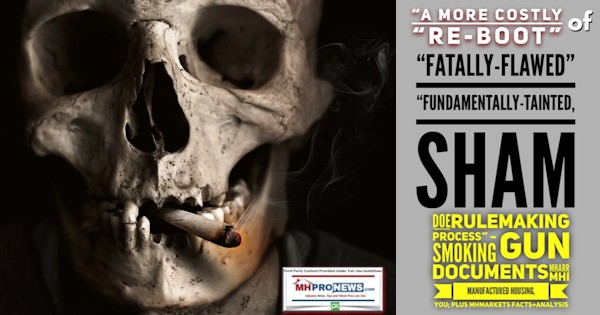



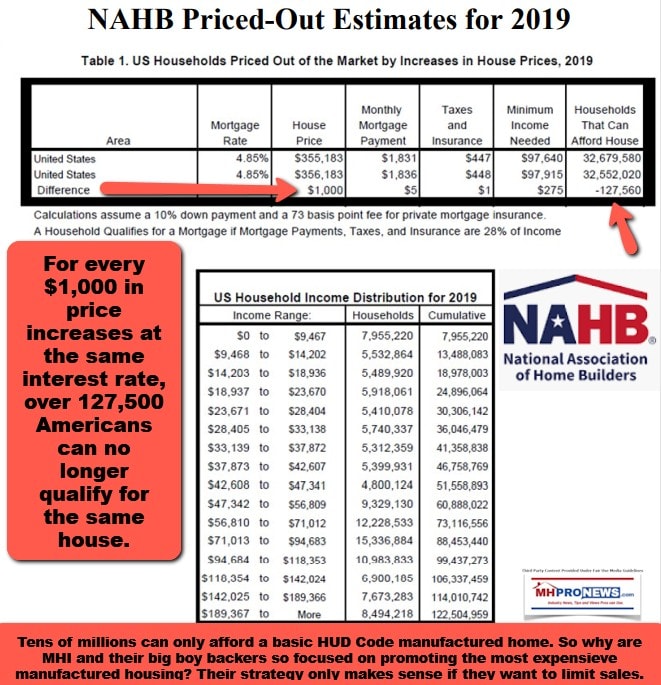
NOTICE: MHProNews is hereby issuing a public notice to MHI leadership to publicly meet at the Biloxi ‘manufactured housing trade show’ and discuss/debate their performance on pressing industry issues in front of a live manufactured housing professional audience. While MHI has ducked such a discussion or debate for years, perhaps they will accept it now? Perhaps they will explain to industry independents why they have been so ineffective at getting good laws that benefit manufactured housing enforced? Or why they have had their fingerprints on the problems related to the DOE energy rule?

MHProNews will keep industry readers apprised of this offer to publicly discuss or debate their performance at the Biloxi event. It would doubtless boost attendance for a show that has strayed from its original moorings. Stay tuned. And ICYMI, don’t miss the report on Biloxi below.

Next up is our daily business news recap of yesterday evening’s market report, related left-right headlines, and manufactured housing connected equities.
The Business Daily Manufactured Home Industry Connected Stock Market Updates. Plus, Market Moving Left leaning CNN and Right-leaning (Newsmax) Headlines Snapshot. While the layout of this daily business report has been evolving over time, several elements of the basic concepts used previously are still the same. For instance. The headlines that follow below can be reviewed at a glance to save time while providing insights across the left-right media divide. Additionally, those headlines often provide clues as to possible ‘market-moving’ news items.
Market Indicator Closing Summaries – Yahoo Finance Closing Tickers on MHProNews…
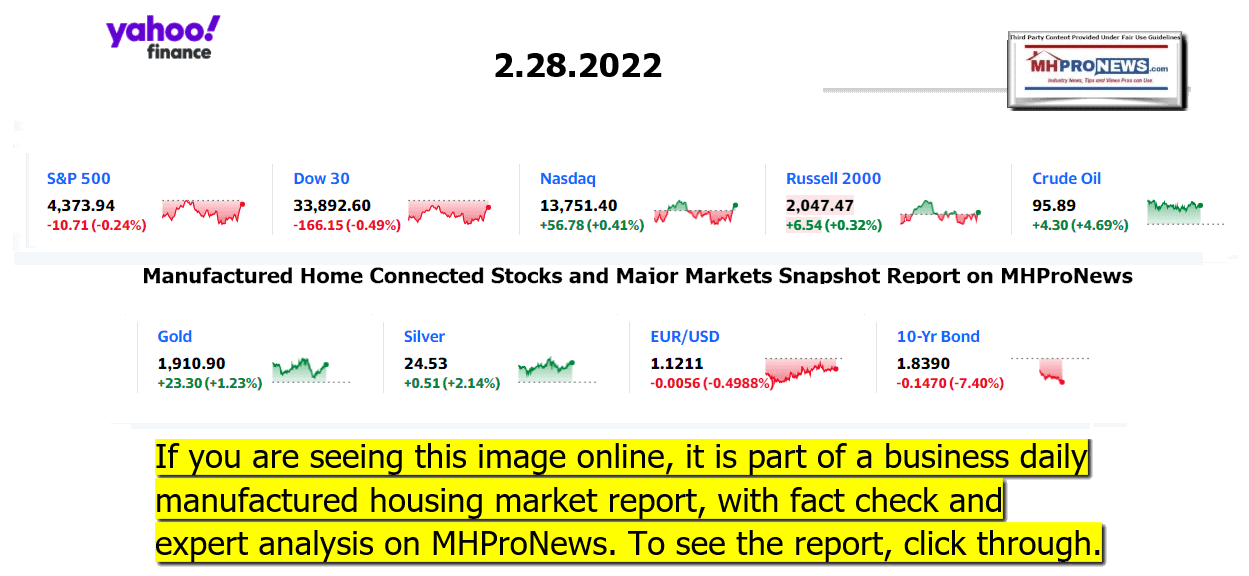
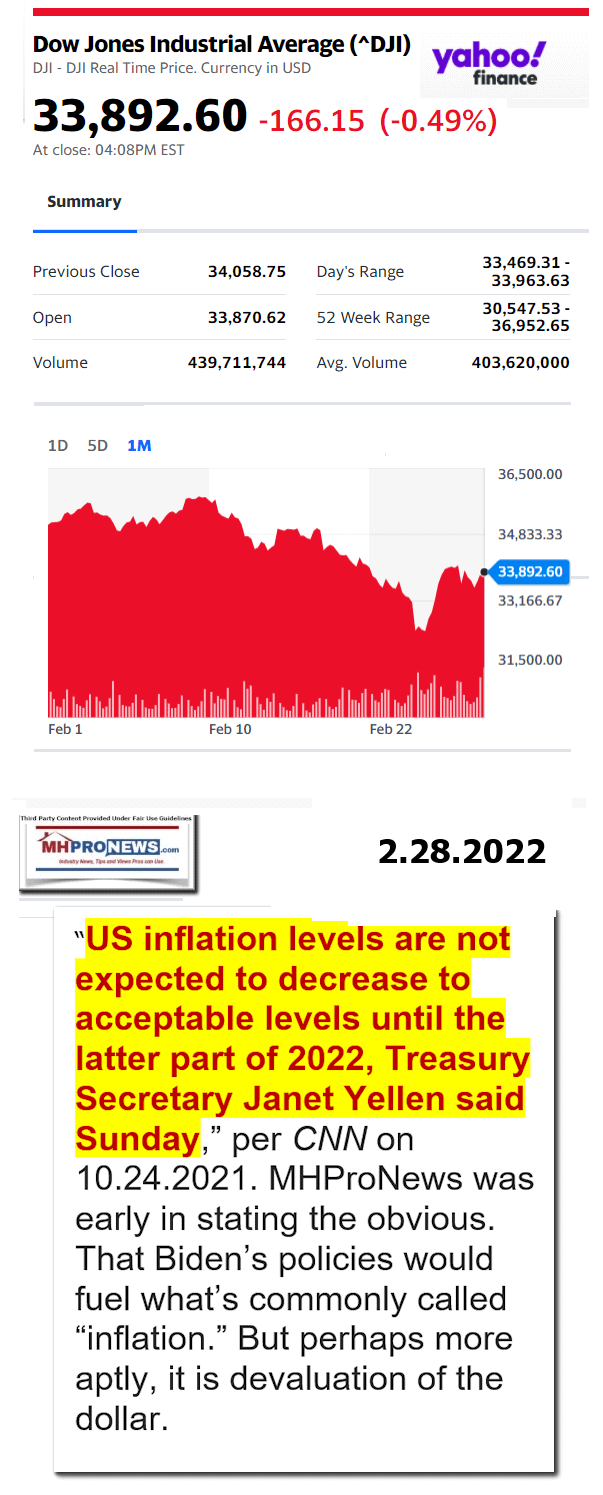
Headlines from left-of-center CNN Business – from the evening of 2.28.2022
- Preparing for the worst
- A Sayda compressor station connecting the Czech Gazela pipeline with German OPAL pipeline is shown in Germany, in November 2021. The Gazela pipeline is used to transit Russian liquefied natural gas (LNG) to the European Union.
- What if Moscow turns off the gas as the Ukraine conflict deepens?
- Break rank: Two Russian oligarchs call for an end to Putin’s war in Ukraine
- Big Oil: Shell follows BP out of Russia as UK oil companies abandon Putin
- Diesel: Just hit $4 a gallon. Here’s why that will cost you
- Toxic: The war in Ukraine has made Russian assets untouchable
- LIVE UPDATES Stocks set to end February lower as Russia threatens the West
- Inflation: It will be worse than feared this year, Goldman Sachs predicts
- No superpower: Russia’s economy is tiny. Why that matters to you
- SWIFT: What is it and how is it being used against Russia?
- Meltdown: Russia’s ruble crashes as its banking system reels
- Wall Street: The invasion of Ukraine changed everything for investors
- Backlash: States want to boycott Russian vodka. Here’s why that won’t work
- Corporations: These international companies have the most to lose from Russia’s attack
- Meta: Has shut down a pro-Russian disinformation network, warns of a social media hacking operation
- Oligarchs: Russian billionaires lost nearly $40 billion in stock market rout
- At home: Why the Russian invasion will have huge economic consequences for American families
- Media: Why Russia’s invasion of Ukraine is being called the ‘TikTok war’
- Analysis: Americans are not being well served in Ukraine coverage
- LATEST HEADLINES
- Refugees fleeing conflict in neighboring Ukraine arrive to Przemysl, Poland, Saturday, Feb. 26, 2022. As hundreds of thousands of Ukrainians seek refuge in neighboring countries, cradling children in one arm and clutching belongings in the other, leaders in Poland, Hungary, Bulgaria, Moldova and Romania are offering a hearty welcome.
- Airbnb offering free temporary housing for up to 100,000 Ukrainian refugees
- Target boosts its starting pay for some jobs to $24 an hour
- Amazon will no longer require US warehouse employees to wear masks
- Estée Lauder fires senior executive for offensive Instagram post
- Have student debt? Hear some expert tips on how to manage it
- Welcome to Diversifying, a new money podcast for a changing world
- Chris Licht introduces himself to CNN as its next CEO
- Malls aren’t for shopping anymore. Think pickleball and craft beer
- BitConnect founder charged with orchestrating $2 billion Ponzi scheme
- Which Batman actor has made the most at the ticket booth?
- Warren Buffett’s Berkshire Hathaway posts nearly $40 billion profit
- Bitcoin is getting even dirtier
- As Americans pay more for everything, the price of weed drops
- Wendy’s burgers are square for a reason. Here’s why
- Foot Locker says its sales will plummet this year. Blame Nike
- META
- In this Friday, Oct. 25, 2019, file photo, Facebook CEO Mark Zuckerberg speaks about "News Tab" at the Paley Center, in New York.
- Texas sues Meta for collecting facial recognition data
- Avatars will have a four-foot buffer zone
- Meta has worst trading day in history
- Meta is building an AI supercomputer
- Couple plan India’s ‘first metaverse marriage’
- AVIATION
- Passengers wait at Pushkin Sheremetyevo International Airport, in Moscow's region, while canceled flights are shown on the departure boards in the background, on February 24.
- How the Russian invasion of Ukraine is impacting global aviation
- British Airways cancels Moscow flights
- Airlines scramble as Ukraine invasion redraws route map
- Latvia’s airline suspends overnight flights to Ukraine
- Airlines cancel Ukraine flights as threat of war grows
Headlines from right-of-center Newsmax – evening of 2.28.2022
- Ukraine Talks Yield No Breakthrough as Russians Close In
- Ukrainian and Russian national flags are placed on the table ahead of peace talks between Russian and Ukrainian delegations in a guest house in the Gomel region, Belarus, is seen Monday. (Sergei Kholodilin/BelTA Pool Photo via AP)
- Russian Invasion of Ukraine
- 17-Mile Russian Convoy Near Kyiv
- US: We’ll Add to Russia Sanctions If Moscow Further Escalates
- US States Adding to Financial Squeeze on Russia
- Ukraine Talks Yield No Breakthrough as Russians Close In
- Putin-Hired Mercenaries in Kyiv to Kill Zelenskyy: Report
- Ukraine, Allies Prod UN to Probe Russian War Crimes
- Int’l Banks, Funds & Exchanges Enact Sanctions
- BP Abandons Russia, Takes $25 Billion Writedown
- Russia Hikes Rates, Adds Capital Controls as Sanctions Bite
- Kharkiv Bombing: ‘Dozens of Dead and Hundreds of Wounded’
- Twitter Crackdown on Tweets Tied to Russian State Media
- Zelenskyy Signs Request for Ukraine to Join EU
- IOC: Ban Russia, Belarus Athletes From Global Events
- More Russian Invasion of Ukraine
- Newsmax TV
- Clyde: Biden Energy Policy ‘Took Away Club’ Against Russia
- Clyde: Biden Energy Policy ‘Took Away Club’ Against Russia | video
- Waltz to Newsmax: Putin May Start ‘Scorched-Earth’ Attacks on Ukraine | video
- Mo Brooks: Biden’s State of the Union Won’t Reflect Failures | video
- Ernst: US Must Regain Leadership Role on Ukraine | video
- Issa: US Must Provide Ukraine With What It Needs | video
- Andrei Illarionov: Putin Threatening US With ‘Nuclear Blackmail’ | video
- Nigel Farage: Putin Made ‘Disastrous Decision’ With Invasion | video
- More Newsmax TV
- Newsfront
- AP-NORC Poll: Pandemic Fears Subsiding
- Omicron is fading away, and so are Americans’ worries about COVID-19. As coronavirus pandemic case numbers, hospitalizations and deaths continue to plummet, fewer people now than in January say they are concerned that they will be infected after the rise and fall…… [Full Story]
- DeSantis Won’t Send Florida Guard to State of the Union
- Florida Republican Gov. Ron DeSantis said Monday that members of the [Full Story]
- Ukraine Calls for UN Inquiry Into Russian War Crimes
- Ukraine and its allies had called for a United Nations inquiry Monday [Full Story]
- Russia’s ‘Super-EMP’ Nuke, Massive Military Could Roll NATO
- Russia could win World War III in Europe with a single Super-EMP [Full Story] | Platinum Article
- McLaughlin Poll: Only 23% of Dem Primary Voters Want Biden Again
- Just 23% of Democratic primary voters would choose President Joe [Full Story]
- Putin Issues ‘Clear Nuclear Threat’ as Biden Diminishes US Deterrent
- Russian President Vladimir Putin’s decision on Sunday to place his [Full Story] | Platinum Article
- Federal Prosecutor: Jan. 6 Probe ‘Still Somewhere in the Middle’
- A federal prosecutor said his office is “still somewhere in the [Full Story]
- Where WHO’s Aim to Vaccinate 70% of World by June Stands
- Vaccinating 70% of the population in every country in the world [Full Story]
- Related
- How Americans Are Reacting to the New CDC Mask Guidance
- California, Oregon, Washington to End School Mask Mandates
- With Ruble Worth Less Than One Cent, Wall Street Set for Decline
- S. markets pointed toward a lower open Monday and the ruble plunged [Full Story]
- Twitter Will Label, Reduce Visibility of Tweets Linking to Russian State Media
- Twitter is adding labels and reducing the visibility for tweets [Full Story]
- Derek Jeter Leaves Post as Miami Marlins’ CEO, Shareholder
- Derek Jeter went into the offseason talking about the Miami Marlins [Full Story]
- FIFA, UEFA Suspend Russian Teams From International Soccer
- FIFA and UEFA have suspended Russia’s national teams and clubs from [Full Story]
- Putin-Hired Mercenaries in Kyiv to Kill Zelenskyy: Report
- More than 400 Russian-paid mercenaries have infiltrated Kyiv focused [Full Story]
- Richard Blum, Husband of California Sen. Feinstein, Dies at 86
- Richard Blum, husband of California Sen. Dianne Feinstein, died [Full Story]
- Bolton: Bar All Russians From Entering Europe, US
- Former National Security Adviser John Bolton called on the U.S. and [Full Story]
- Trump Recalls He Drove NATO Spending, Anti-Tank Missiles
- Former President Donald Trump put out a statement on Monday that it [Full Story]
- West Virginia AG Morrisey: EPA Case Vital in Separation of Powers Argument
- A case challenging the Environmental Protection Agency’s powers when [Full Story]
- IOC: Ban Russian, Belarusian Athletes From International Events
- The International Olympic Committee’s executive board has recommended [Full Story]
- Target Seeks to Entice Workers With Pay of up to $24 an Hour
- Workers at Target stores and distribution centers in places like New [Full Story]
- Supreme Court Weighing Challenge to EPA’s Climate Change Powers
- The Supreme Court Monday will be hearing oral arguments in a case [Full Story]
- Sanctions Cause Gas Price Hike in Russia
- Economic sanctions imposed on Russia following the invasion of [Full Story]
- California, Oregon, Washington to End School Mask Mandates
- Students in California, Oregon, and Washington will no longer be [Full Story]
- Texas Ranchers Reject Biden Administration Aid for Migrant Damages
- Texas ranchers are turning down the Biden administration for money [Full Story]
- UN Climate Report: ‘Atlas of Human Suffering’ Worse, Bigger
- Deadly with extreme weather now, climate change is about to get so [Full Story]
- Facebook-Owner Meta Says Ukraine’s Military, Politicians Targeted in Hacking Campaign
- Meta Platforms said a hacking group used Facebook to target a handful [Full Story]
- NY to Lift Statewide School Mask Mandate by March 2
- New York’s statewide masking requirement in schools will be lifted by [Full Story]
- NYT: New Research Suggests COVID-19 Originated from Wet Market
- A pair of new research studies suggest COVID-19 was released from a [Full Story]
- Clyburn Urges ‘Strong Bipartisan Support’ for SCOTUS Pick
- Even though he did not get his first choice for a new justice on the [Full Story]
- Russia’s Sleeper Agents in Ukraine Identified
- Soon after Russia invaded Ukraine on the night of Feb. 24, painted [Full Story]
- NKorea Says It Conducted Test for Developing Reconnaissance Satellite
- North Korea said a test conducted on Sunday was for the development [Full Story]
- Gingrich: Biden’s ‘Disastrous Administration’ Ending Post-WWII Security
- With Vladimir Putin’s testing of NATO and putting his nuclear [Full Story]
- More Newsfront
- Finance
- Russian Economy Struggling to Deal With Sanctions
- Russia’s economy was trying to avert disaster Monday after feeling the effects of severe sanctions imposed following President Vladimir Putin’s invasion of Ukraine…. [Full Story]
- Russia Sanctions Snarl Flights, Compound Airline Industry Woes
- Int’l Banks, Funds & Exchanges Put Russian Sanctions Into Action
- Russia Hikes Rates, Introduces Capital Controls as Sanctions Bite
- Citigroup Says Total Russian Exposure Nearly $10 Billion
- More Finance
- Health
- AP-NORC Poll: Pandemic Fears Subsiding
- Omicron is fading away, and so are Americans’ worries about COVID-19. As coronavirus pandemic case numbers, hospitalizations and deaths continue to plummet, fewer people now than in January say they are concerned that they will be infected after the rise and fall…… [Full Story]
- How to Recognize and Treat Emotional Issues in Your Pet
- Leg Cramps, Pain Can Be an Early Sign of Serious Condition
- Genetic Testing Kits Often Reveal Unknown Relatives
- Amazon’s Voice Assistant Alexa to Start Seeking Doctor Help
MHProNews has pioneered in our profession several reporting elements that keep our regular and attentive readers as arguably the best informed in the manufactured housing industry. Among the items shared after ‘every business day’ (when markets are open) is our left-right headline recap summary. At a glance in two to three minutes, key ‘market moving’ news items are covered from left-of-center CNN Business and right-of-center Newsmax. “We Provide, You Decide.” © Additionally, MHProNews provides expert commentary and analysis on the issues that others can’t or won’t cover that help explain why manufactured housing has been underperforming during the Berkshire era while an affordable housing crisis and hundreds of thousands of homeless in America rages on. These are “Industry News, Tips, and Views Pros Can Use” © features and others made and kept us the runaway #1 in manufactured housing trade publisher for a dozen years and counting.

Manufactured Housing Industry Investments Connected Equities Closing Tickers
Some of these firms invest in manufactured housing, or are otherwise connected, but may do other forms of investing or business activities too.
-
-
-
-
-
-
-
-
-
-
-
-
-
- NOTE: The chart below includes the Canadian stock, ECN, which purchased Triad Financial Services, a manufactured home industry lender
- NOTE: Drew changed its name and trading symbol at the end of 2016 to Lippert (LCII).
- NOTE: Deer Valley was largely taken private, say company insiders in a message to MHProNews on 12.15.2020, but there are still some outstanding shares of the stock from the days when it was a publicly traded firm. Thus, there is still periodic activity on DVLY.
-
-
-
-
-
-
-
-
-
-
-
-
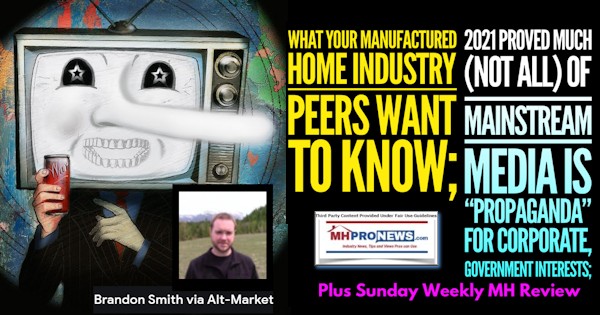


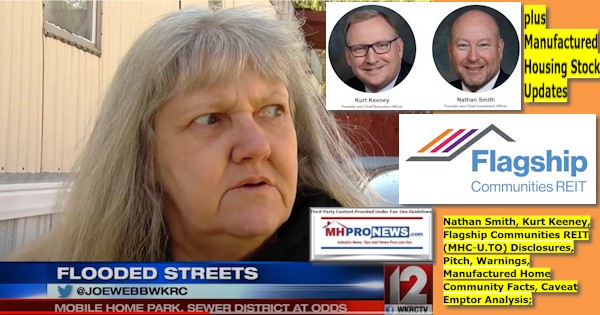
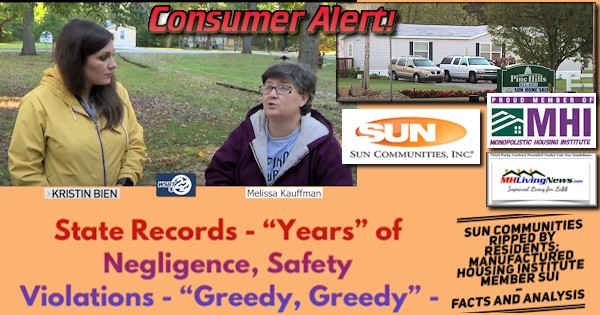
-
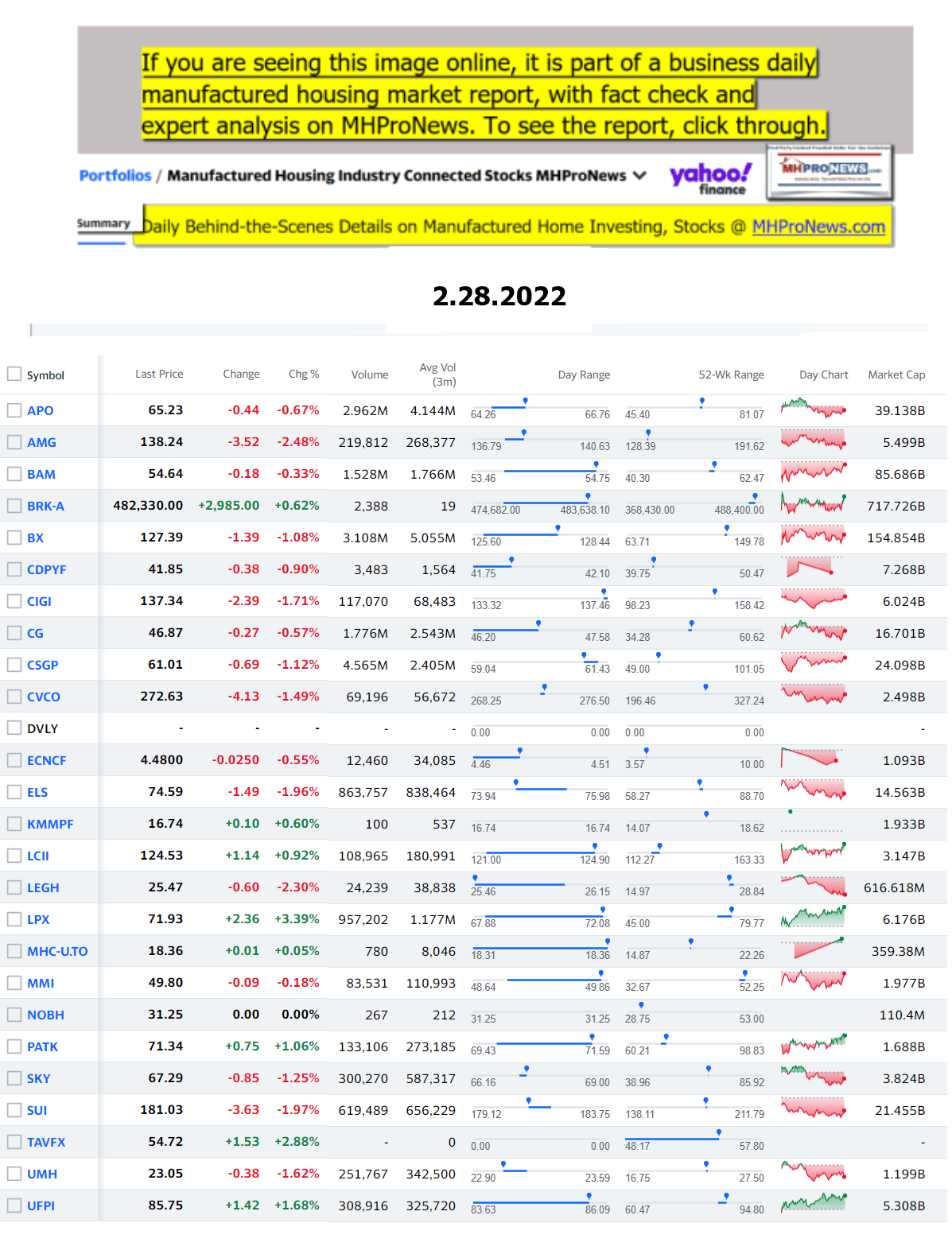
In cases such as Apollo, Berkshire Hathaway, Blackstone or others, manufactured housing may only be part of their corporate interests. Note: depending on your browser or device, many images in this report can be clicked to expand. Click the image and follow the prompts. To return to this page, use your back key, escape or follow the prompts. 
https://www.manufacturedhomepronews.com/steve-lawler-deer-valley-corporation-dvc-otcmkts-dvly-announces-merger-plus-manufactured-home-investing-stock-updates/ 
https://www.manufacturedhomepronews.com/nobility-homes-financial-position-very-strong-sales-strong-but-challenges-including-lending-and-others-examined-plus-manufactured-housing-stocks-update/ - 2022 …Berkshire Hathaway is the parent company to Clayton Homes, 21st Mortgage, Vanderbilt Mortgage and other factory-built housing industry suppliers.
· LCI Industries, Patrick, UFPI, and LP each are suppliers to the manufactured housing industry, among others.
· AMG, CG, and TAVFX have investments in manufactured housing related businesses. For insights from third-parties and clients about our publisher, click here.
Enjoy these ‘blast from the past’ comments. MHProNews. MHProNews – previously a.k.a. MHMSM.com – has celebrated our 11th year of publishing and have completed over a dozen years of serving the industry as the runaway most-read trade media.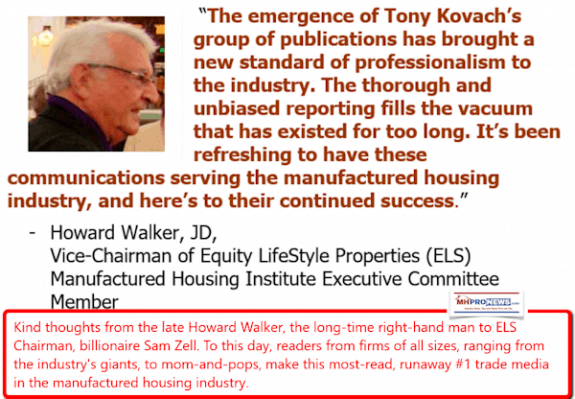
- 2022 …Berkshire Hathaway is the parent company to Clayton Homes, 21st Mortgage, Vanderbilt Mortgage and other factory-built housing industry suppliers.
Sample Kudos over the years…
It is now 12+ years and counting…
Learn more about our evolutionary journey as the industry’s leading trade media, at the report linked below.
· For expert manufactured housing business development or other professional services, click here.
· To sign up in seconds for our industry leading emailed headline news updates, click here.
Disclosure. MHProNews holds no positions in the stocks in this report.
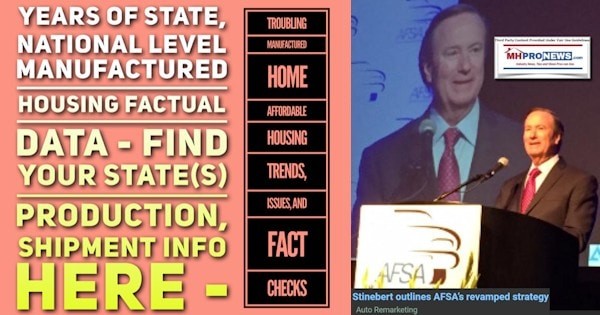


That’s a wrap on this installment of “News Through the Lens of Manufactured Homes and Factory-Built Housing” © where “We Provide, You Decide.” © (Affordable housing, manufactured homes, stock, investing, data, metrics, reports, fact-checks, analysis, and commentary. Third-party images or content are provided under fair use guidelines for media.) (See Related Reports, further below. Text/image boxes often are hot-linked to other reports that can be access by clicking on them.)

By L.A. “Tony” Kovach – for MHProNews.
Tony earned a journalism scholarship along with numerous awards in history. There have been several awards and honors and also recognition in manufactured housing. For example, he earned the prestigious Lottinville Award in history from the University of Oklahoma, where he studied history and business management. He’s a managing member and co-founder of LifeStyle Factory Homes, LLC, the parent company to MHProNews, and MHLivingNews.com. This article reflects the LLC’s and/or the writer’s position and may or may not reflect the views of sponsors or supporters.

